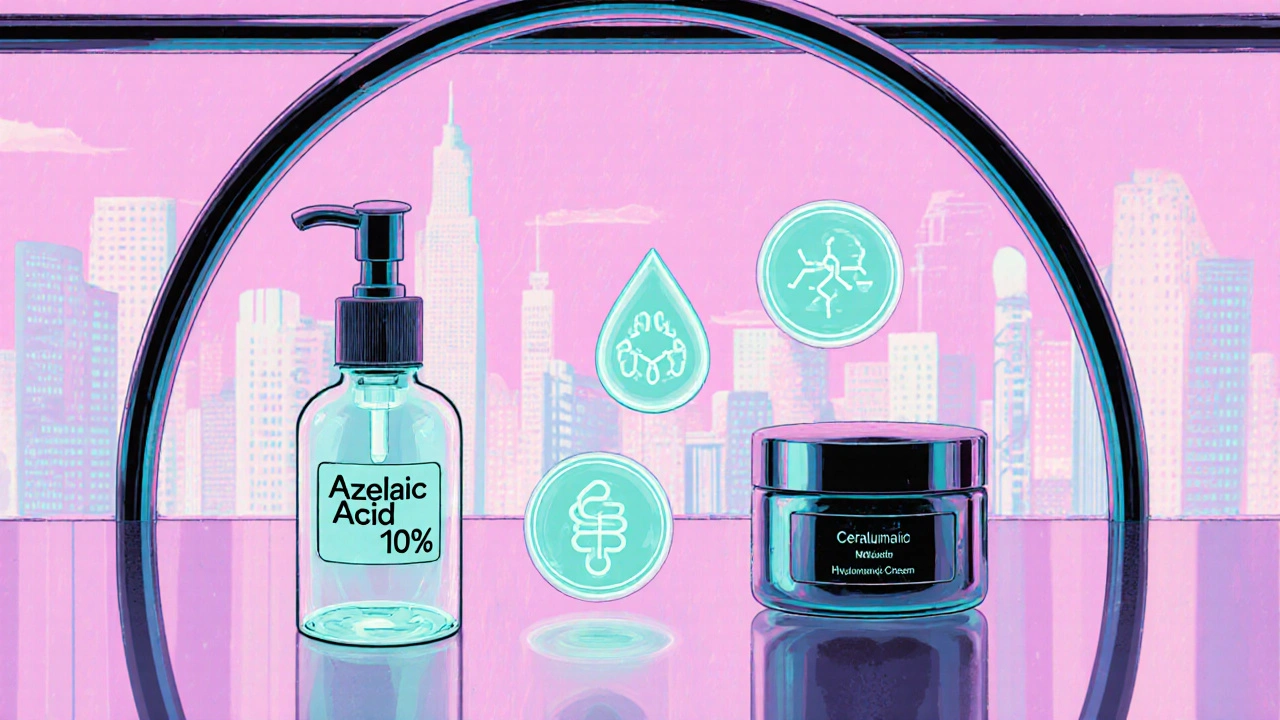Azelaic Acid Compatibility Checker
Check Your Skincare Compatibility
Select ingredients you're using with azelaic acid to get personalized layering guidance
Quick Takeaways
- Azelaic Acid works well with niacinamide, hyaluronic acid, and ceramides.
- Avoid mixing it right after strong acids like vitamin C or retinol without buffering.
- Layer from thinnest to thickest texture and give each product 5‑10 minutes to absorb.
- Start with low concentrations (5‑10%) and watch how your skin responds before adding more actives.
- Consistent use for 8‑12 weeks shows the most noticeable improvement.
When you hear the name Azelaic Acid is a naturally occurring dicarboxylic acid found in grains such as barley, wheat, and rye. Its ability to reduce inflammation, unclog pores, and fade dark spots makes it a favorite for acne‑prone and hyperpigmentation‑concerned skin.
But azelaic acid rarely works in isolation. Pairing it with the right companions can amplify its effects, while the wrong mix can cause irritation or cancel out benefits. Below we break down the science, offer a step‑by‑step layering guide, and provide a handy compatibility chart.
Understanding Azelaic Acid’s Core Actions
Three mechanisms drive azelaic acid’s popularity:
- Keratinocyte normalization - it slows down the over‑production of keratin, preventing clogged pores.
- Anti‑inflammatory properties - it dampens the redness that often follows breakouts.
- Melanin synthesis inhibition - it interferes with the enzyme tyrosinase, lightening post‑inflammatory marks.
Because these actions are gentle yet effective, azelaic acid sits comfortably at a “mid‑range” pH (around 4.5) and can be formulated as a serum, cream, or foam.
Key Ingredients to Pair With Azelaic Acid
Below are the most common actives you’ll find in a modern routine. Each paragraph introduces the ingredient with microdata markup, explains its main benefit, and notes how it interacts with azelaic acid.
Niacinamide is a form of vitamin B3 that improves barrier function and reduces excess oil. It shares anti‑inflammatory properties with azelaic acid, so stacking them can calm redness without upping irritation risk. Because niacinamide works best at a neutral pH (around 6), it can be applied right after azelaic acid without conflict.
Hyaluronic Acid is a humectant that can hold up to 1,000 times its weight in water. It doesn’t react chemically with azelaic acid and instead helps lock in moisture, which mitigates the mild drying effect some people feel.
Ceramides are lipid molecules that rebuild the skin’s protective barrier. Using ceramide‑rich creams after azelaic acid reinforces barrier repair, making the overall regimen gentler.
Vitamin C (L‑Ascorbic Acid) is a potent antioxidant that brightens skin by neutralizing free radicals. It prefers a low pH (around 3) for optimal absorption. Applying it directly before azelaic acid can lower the latter’s pH, reducing its efficacy, and may cause a tingling sensation. If you love both, use vitamin C in the morning and azelaic acid at night.
Retinol (vitamin A derivative) accelerates cell turnover and stimulates collagen. Retinol works best at a slightly higher pH and can be harsh when paired with other acids. Alternate nights or use a buffering moisturizer in between to keep irritation low.
Salicylic Acid is a beta‑hydroxy acid (BHA) that dissolves oil inside pores. Because both salicylic and azelaic acids target clogged pores, using them together can be over‑kill and lead to dryness. If you need both, apply salicylic acid in the morning and azelaic acid in the evening.
Benzoyl Peroxide is a radical‑forming agent that kills acne‑causing bacteria. It’s very oxidizing and can degrade azelaic acid, making the combo less effective. Keep them separate by day versus night or opt for a lower concentration of each.
Lactic Acid is an alpha‑hydroxy acid (AHA) that exfoliates the skin surface. Like other AHAs, it lowers pH and can increase sensitivity when used with azelaic acid. Pair them only if you’re an experienced user and limit usage to 2‑3 times a week.
Peptides are short chains of amino acids that signal collagen production. They are pH‑neutral and sit comfortably over azelaic acid, adding anti‑aging benefits without irritation.

How to Layer for Maximum Benefits
- Cleanse: Use a gentle, sulfate‑free cleanser to avoid stripping the barrier.
- Tone (optional): If you use a watery, alcohol‑free toner, apply it now and let it fully absorb (about 30 seconds).
- Apply water‑based actives first: This includes vitamin C (morning) or azelaic acid (night). Pat gently; don’t rub.
- Give a buffer window: Wait 5‑10 minutes before moving to the next layer. This lets the first product settle at its intended pH.
- Follow with niacinamide or hyaluronic acid: These molecules are lightweight and can sit atop the acid layer without interfering.
- Seal with moisturizer containing ceramides or peptides: This locks in hydration and supports barrier repair.
- Finish with sunscreen (morning): Broad‑spectrum SPF 30+ is mandatory when using any acid.
When you need a stronger spot‑treatment, use a small amount of azelaic acid directly on the blemish after the serum step, then continue with the rest of the routine.
Compatibility Chart
| Ingredient | Compatibility | Key Benefit When Paired |
|---|---|---|
| Niacinamide | Highly compatible | Enhanced barrier, reduced redness |
| Hyaluronic Acid | Highly compatible | Improved hydration, less dryness |
| Ceramides | Highly compatible | Barrier repair, soothing effect |
| Vitamin C (L‑Ascorbic Acid) | Potential conflict (pH) | Brightening (if separated by time of day) |
| Retinol | Potential conflict (irritation) | Anti‑aging (if alternated nights) |
| Salicylic Acid | Potential conflict (over‑exfoliation) | Deep pore cleaning (if used at different times) |
| Benzoyl Peroxide | Potential conflict (oxidation) | Acne control (if separated) |
| Lactic Acid | Potential conflict (pH) | Surface exfoliation (if limited frequency) |
| Peptides | Highly compatible | Collagen boost, anti‑aging |
Common Mistakes and How to Fix Them
- Mixing acids in one step: Layering two low‑pH acids (like azelaic acid + vitamin C) can cause a burning sensation. Solution: separate by at least 5‑10 minutes or use on alternate days.
- Skipping the buffer period: Going straight from serum to heavy cream can dilute the acid’s effect. Wait a few minutes for full absorption.
- Over‑using high concentrations: Jumping from 5% to 20% azelaic acid quickly leads to redness. Gradually increase concentration over 2‑3 weeks.
- Neglecting sunscreen: Even gentle acids increase photosensitivity. Apply SPF 30+ every morning, reapplied every two hours if outdoors.

Sample Routine for Sensitive Skin
- Morning
- Gentle cleanser
- Vitamin C serum (10% L‑Ascorbic Acid)
- Moisturizer with ceramides
- SPF 30+
- Evening
- Cleanser
- Azelaic Acid 10% serum
- Niacinamide serum
- Hyaluronic Acid lightweight gel
- Barrier‑repair cream with peptides
This split‑day approach keeps brightening and acne‑fighting actives separated while still delivering their full benefits.
Frequently Asked Questions
Can I use azelaic acid and retinol on the same night?
It’s best to avoid them together if your skin is prone to irritation. Either alternate nights or apply a thin moisturizer between the two to buffer the pH shift.
How long before I see results with azelaic acid?
Most users notice smoother texture and reduced redness after 4‑6 weeks, while noticeable fading of dark spots can take 8‑12 weeks of consistent use.
Is azelaic acid safe for pregnant or breastfeeding women?
Dermatologists generally consider it low‑risk, but it’s wise to stick with a 10% over‑the‑counter formula and consult your doctor first.
Can I apply a moisturizer before azelaic acid?
Applying moisturizer first can dilute the acid’s penetration, reducing its effectiveness. Use the acid on bare skin, then moisturize.
What concentration should beginners start with?
A 5% to 10% formulation is ideal for beginners. Patch test on the jawline for three days before full‑face use.
Next Steps & Troubleshooting
If you’ve followed the layering guide and still experience stinging, consider these adjustments:
- Reduce azelaic acid concentration to 5% for two weeks. \n
- Increase the buffer window to 10‑15 minutes.
- Swap any additional low‑pH actives (like AHA serums) for a week and re‑introduce gradually.
- Check your cleanser - harsh sulfates can compromise barrier function.
When irritation subsides, you can slowly re‑add the other actives, watching for any flare‑ups. Consistency is key; most skin improves after the initial adjustment period.
azelaic acid can be a star player in a balanced routine, but it shines brightest when teamed with the right partners and applied in the right order.


Brandy Eichberger
October 21, 2025 AT 14:16Ah, the art of pairing azelaic acid is akin to composing a symphony; each ingredient must play its part in harmony. Niacinamide and hyaluronic acid, for instance, provide the delicate counterpoint that soothes the skin while the acid does the heavy lifting. I adore the suggestion of buffering periods-patience is a virtue rarely observed in modern skincare routines. Remember, the skin's barrier is a fragile tapestry; treat it with the reverence it deserves.
Rachel Valderrama
November 1, 2025 AT 13:16Wow, who knew a simple routine could be so over‑engineered-guess we’ll all need PhDs now! Seriously though, if you’re feeling lazy, just slap on the azelaic and forget the rest; the world won’t end. 🙃
Jake Hayes
November 12, 2025 AT 13:16Your layering guide is fundamentally flawed.
parbat parbatzapada
November 23, 2025 AT 13:16Yo man, i think u dont get it-big corp chemists are feeding us these “simple” steps to keep us dependent. They hide the real truth behind fancy buzzwords while they harvest our skin cells. Stay woke, fam.
Casey Cloud
December 4, 2025 AT 13:16First, always start with a gentle cleanser that does not strip your skin's natural oils. Rinse thoroughly and pat dry with a soft towel. Apply azelaic acid to clean, dry skin so it can penetrate effectively. Wait at least five minutes before adding any water‑based serums such as niacinamide. This pause lets the acid settle at its optimal pH. Follow with hyaluronic acid to lock in moisture and prevent dryness. The humectant works well because it does not raise the pH of the underlying layer. Next, introduce a ceramide‑rich moisturizer to reinforce the barrier and soothe any irritation. Ceramides are lipid molecules that fill gaps in the skin’s structure. If you wish to brighten further, use vitamin C in the morning rather than at night. Vitamin C’s low pH can interfere with azelaic acid if applied together. Retinol should be reserved for alternate evenings to avoid over‑exfoliation. When using salicylic acid, keep it to a different time of day to prevent over‑drying. Always finish with a broad spectrum SPF thirty or higher in the daytime. Consistency over eight to twelve weeks will give you the best results.
Eli Soler Caralt
December 15, 2025 AT 13:16Ah, the epistemic dance of dermal alchemy reveals that true beauty is but a fleeting illusion 🌌. One must contemplate the relationship between pH and perception, lest the skin become a mirror of existential dread 😂. Yet, in practice, the humble peptide can bridge the gap between theory and tactile bliss. Remember to honor the skin's autonomy; it is not merely a canvas for our chemical whims. 🌿